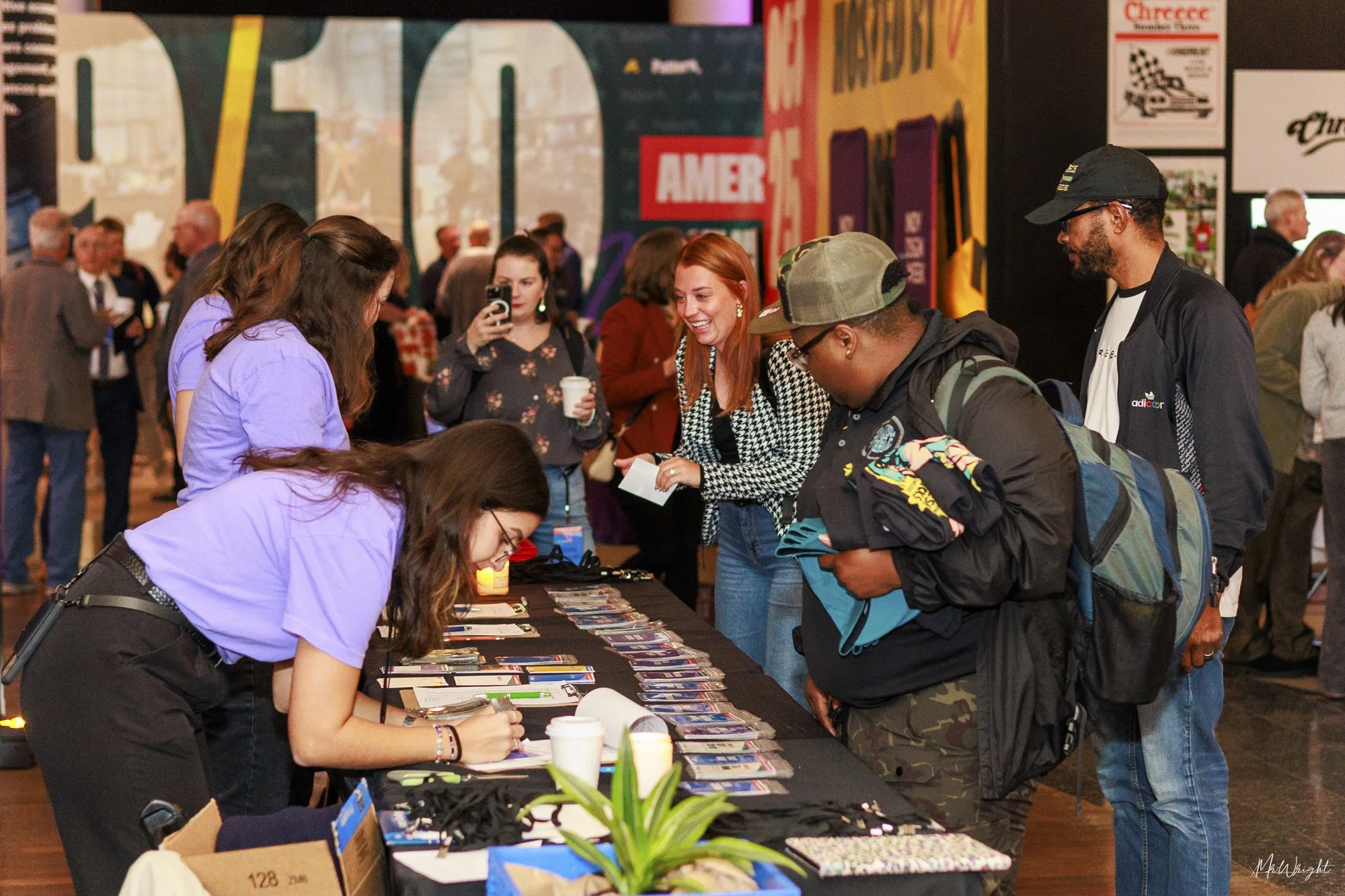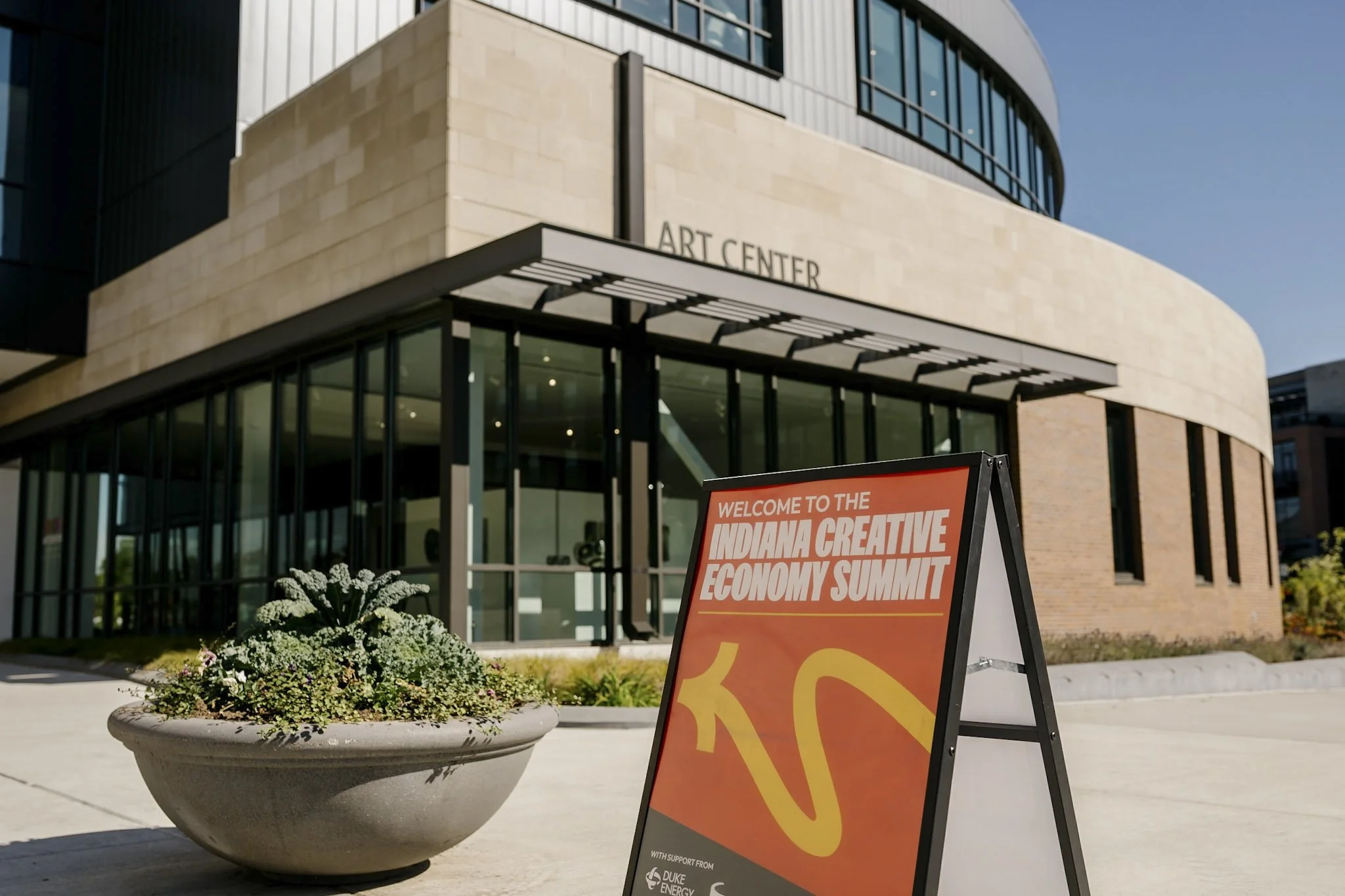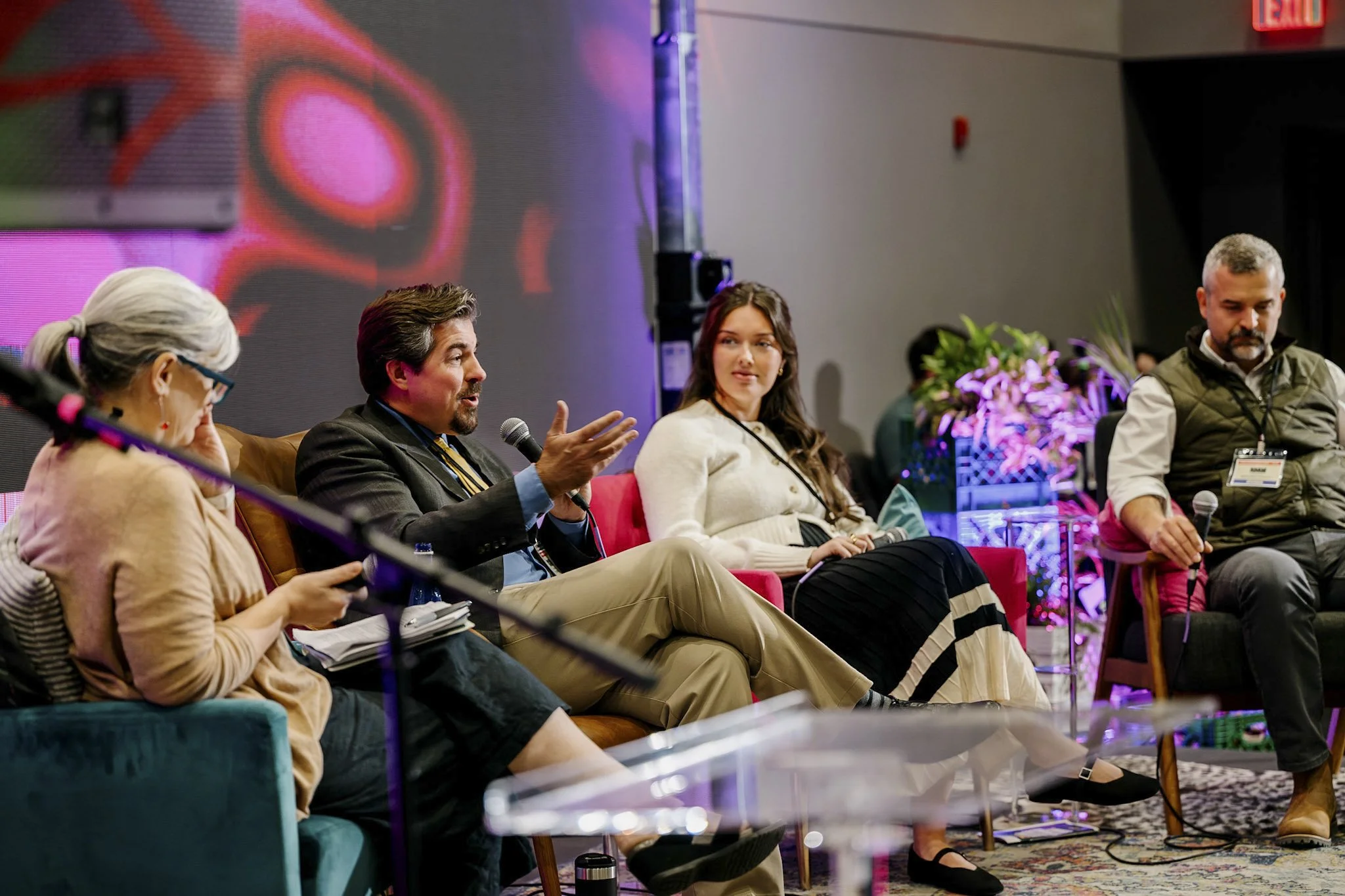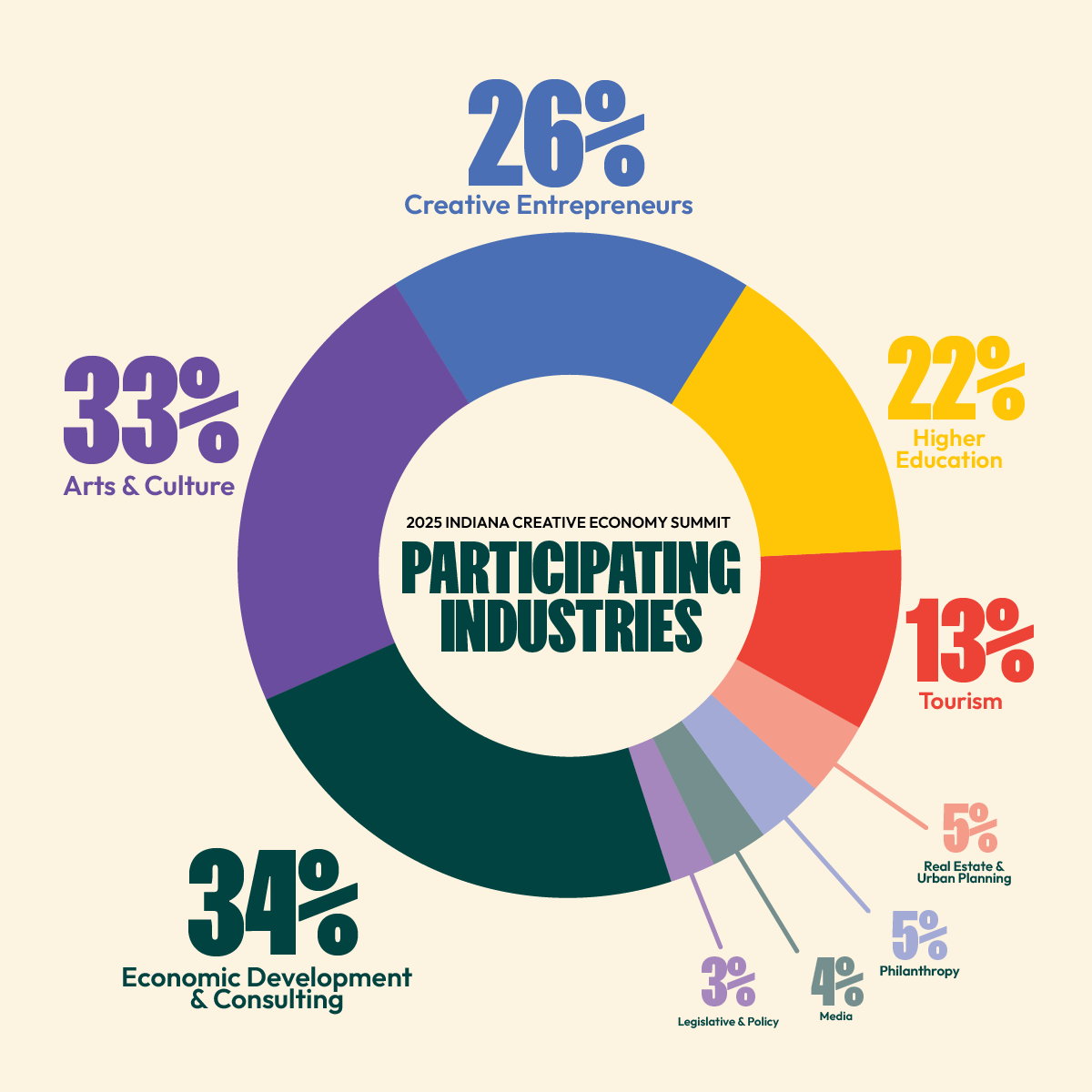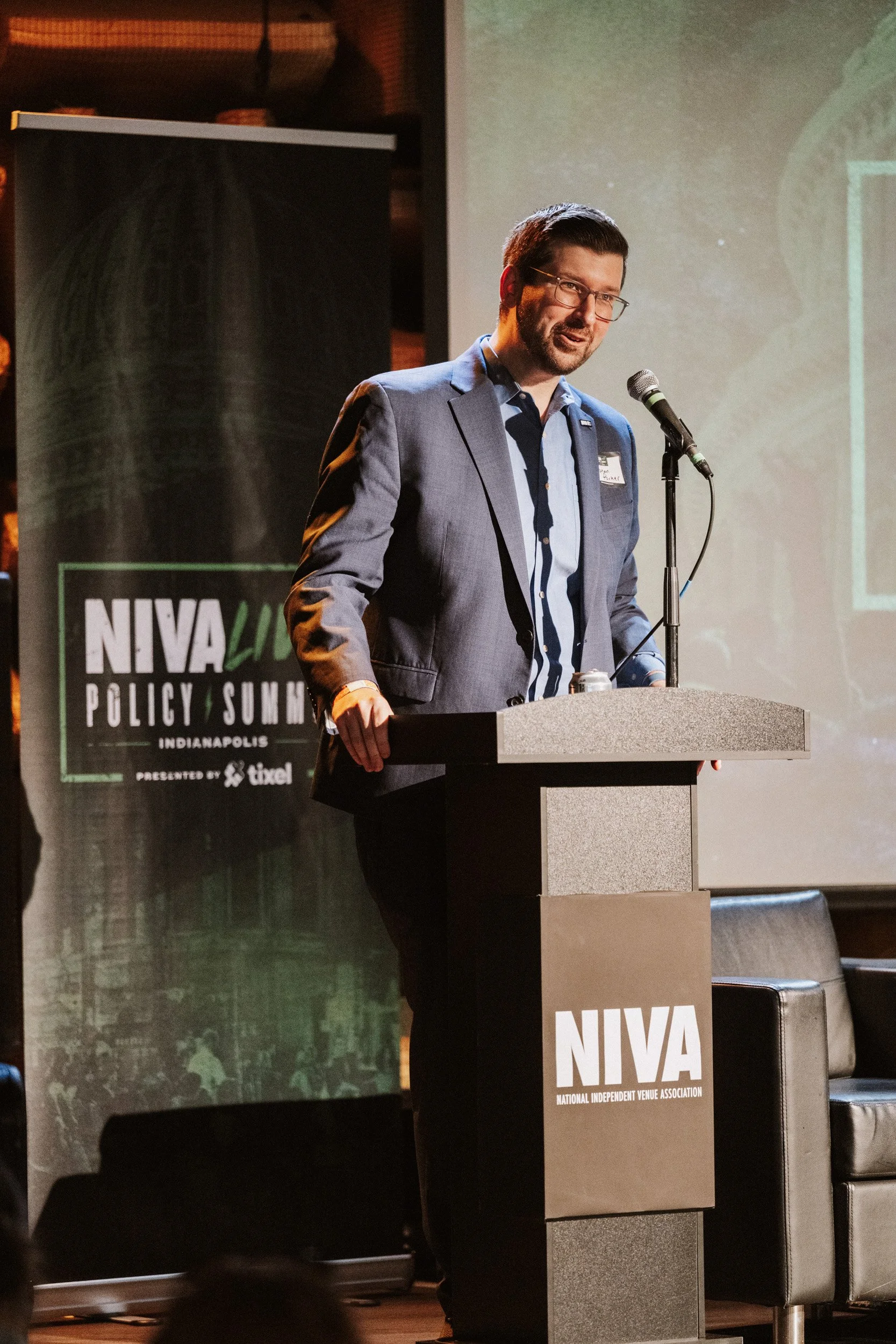BUILDING THE BLUEPRINT:HIGHLIGHTS FROM THE 2025 INDIANA CREATIVE ECONOMY SUMMIT
BY POLINA OSHEROV
Something shifted this year. Ideas turned into action. At our 3rd annual Indiana Creative Economy Summit, held October 13–14 at the Fishers Art Center, conversations didn’t just orbit the “why” of the creative economy; discussions drilled into the “how.” The resulting two days felt less like a conference and more like a blueprint in the making.
This year’s theme, Creativity as Infrastructure, came to life through panels, data, and shared frustrations voiced by a packed room of artists, policymakers, educators, and entrepreneurs. All shared recognition that Indiana has the people and talent, but that the systems supporting them remain fragmented.
Outside of the Fishers Art Center, Fishers, IN
FROM VISION TO STRUCTURE
Moderator NaShara Mitchell opened the conversation with Susan Batchelder (IU Kelley School Business), Carrie Lambert (Indiana Tourism Association), and Dax Norton (Town of Bergersville) in a session that framed creativity as part of the same civic fabric as roads or broadband, an entity that connects, enables, and sustains growth. Dax’s perspective as a town manager hit home for many: progress takes insistence and consistency.
MAKING DATA WORK FOR CREATIVE INDUSTRIES
One of the Summit’s most talked-about moments was the live demo of the Creative Economy Dashboard by Ty Stratton, (Wesley’s Project) a data engineer and former Pattern intern. Designed to visualize Indiana’s creative assets in real time, the tool aims to help leaders make smarter, faster investment decisions. Pattern supported the initial development, but in order to create a truly useful tool—one that utilizes not only a variety of different datasets but also agentic AI—we need partners from all corners and across all industries and sectors. If you are interested in helping build a practical tool with profound potential for our state’s economic future, please reach out.
The excitement around the dashboard transcended mere data. Attendees who witnessed the dashboard in action saw the power and possibilities inherent when moving from anecdotes to evidence.
Moderator and Pattern Executive Director, Polina Osherov (left), with Catlin Whitington, ArtPrize Executive Director (middle) and Vince Kadlubek, Meow Wolf Chief Vision Officer (right)
WHO WAS IN
THE ROOM?
Though attendance was smaller than last year, the mix was stronger and more diverse than ever. Here’s a snapshot of attendees.
A range of voices is what makes our Summit so distinctive. Neither an arts conference, nor a business expo, nor an academic gathering, CES is an event where those worlds meet to design the systems that allow creativity to thrive as part of Indiana’s economic infrastructure.
Summit attendees engaging and sharing their creative economy best practices
LESSONS FROM THE FIELD
From there, conversations widened. With thoughtful moderation by Julie Heath (IU Innovates), the READI regional Arts & Culture studies showcased emerging creative economy work across the state, surfacing both bright spots and barriers: the need for sustainable funding, stronger cross-sector collaboration, and a shared language for talking about creativity and entrepreneurship.
Attendees literally covered the walls with ideas during an interactive playbook session. We collected the suggestions for inclusion in a statewide Creative Economy Playbook, a compilation of best practices, funding models, and success stories from Indiana’s regions.
Julie Heath and Jim Rawlinson share READI Regional Studies
INSPIRATION FROM OUTSIDE INDIANA
Day Two opened with a cross-country perspective from Vince Kadlubek, co-founder of Meow Wolf, and Caitlin Whitington, director of ArtPrize. Their journeys, which originated from throwing small DIY events to managing multi-million-dollar creative enterprises, reminded everyone that big movements start with small experiments and relentless iteration. Both visionaries stressed an urgent message: Indiana doesn’t need to wait for permission to think big.
Another 2025 CES highlight was the Entertainment Economy panel moderated by Marlon Webb (KSM), with panelists Chris Cobb (Music Venue Alliance Nashville), Howie Kaplan (The Civic Theatre in New Orleans), and Michael Hussain (Good Vibes Media). They explained how cities like Nashville and New Orleans have built thriving entertainment ecosystems through clear policy frameworks, flexible permitting, and consistent advocacy. Howie, in particular, struck a chord: he showed how business discipline and community vision can coexist, “using influence to advance the creative sector, not just your own interests.”
MAIN STREET MOMENTUM
Our closing conversation, Main Street Strategies for Growth, brought the focus back to Indiana. Moderator Sarah Peterson led Mayor Richard Strick (Huntington, IN), Alyssa Woolard (City of Plainfield), and Adam Kenney (Bridgeway Capital) through a practical look at how creative entrepreneurs can anchor downtown revitalization. Adam’s insights, describing how community development finance institutions (CDFIs) invest in creative businesses, lit up the room. Many attendees named it a top highlight, “incredibly brilliant and vital.”
Sara Peterson, Mayor Richard Strick, Alyssa Woolard, and Adam Kenney (left to right)
TWO DAYS, ONE THEME
If there was a single thread running through every session, it was the call for connection.
Attendees repeatedly named the need for:
– More “money × creatives” face time
– Shared messaging to advocate as one sector
– A shift in language when talking about creativity and business
– More representation of marginalized voices and POC leadership
– And, as one participant put it, “core wins we can all point to”
There was plenty of humor, too. Someone quipped that when asked what city Indiana should aspire to emulate, the room said “Madison, IN.” The laughter wasn’t cynical, but rather a shared realization that the opportunities are great and the time to act is now.
LOOKING AHEAD
We want to reiterate that the Summit is designed for organizational leaders working at the ecosystem level within their respective creative industries—especially those interested in creating the conditions that make creative work of all kinds possible and sustainable through sound policy and strategic investment. Our goal is to strengthen understanding of the economic power of Indiana’s creative industries, ensure that impact is fairly recognized, and see those dollars reinvested in the people and places driving Indiana’s creative future.
For individual artists & creators, the best way to engage is through local and regional industry specific organizations that channel creative-sector needs upward into these broader conversations. Creative entrepreneurs face a different challenge: the resources that exist for small businesses often don’t feel made for them. At Pattern, our efforts include making those tools more visible and accessible, so that creative founders see themselves in Indiana’s entrepreneurship ecosystem.
Our 2025 Summit closed with sober optimism. No one pretended the work would be easy, but few left discouraged. As one survey response noted, “This conversation is needed in Indiana, and there is a lot of opportunity to grow the creative economy.”
Pattern will continue convening leaders through smaller regional sessions and will release the first draft of the Indiana Creative Economy Playbook in 2026. Our goal is not to replicate other states’ models but to design one which is unmistakably Indiana, rooted in collaboration, practicality, and a belief that creativity belongs at the center of our future.
Once again, this Summit proved that when arts leaders, entrepreneurs, economic development and tourism professionals, higher ed, and philanthropy sit at the same table, Indiana gets interesting.
NATIONAL INDEPENDENT VENUE ASSOCIATION SUMMIT TAKES THE LOCAL STAGE
The 2025 National Independent Venue Alliance (NIVA) Live Policy Summit took place immediately following the Creative Economy Summit, on October 15-16, bringing together venue owners, policymakers, and advocates from across the country for two days of big ideas and lively debate about the future of independent live entertainment.
Thanks to some persistent nudging (we at Pattern take a little credit), the NIVA team chose Indy, and HI-FI proved to be the perfect host, setting the tone for a summit both deeply practical and full of heart.
The sessions were anchored by new findings from the State of Live Report, which underscored the scale and urgency of this industry’s impact. Nationally, independent venues contributed $86.2 billion to GDP, supported 908,000 jobs, and generated $19.3 billion in tax revenue, even as 64 percent operated without profitability in 2024. In Indiana, the sector drives $578.9 million in GDP, $1 billion in total output, and supports over 8,000 jobs, proving that live music is far more than nightlife—it’s economic development in action.
Policy conversations focused on the local levers that matter most: zoning, permitting, and nightlife governance. Several cities—including New Orleans, Austin, Nashville, and Philly—shared examples of nightlife offices and entertainment districts that protect and nurture creative spaces amid urban growth.
The energy in HI-FI was exhilarating. Unlike a typical industry event, the conference resembled a friendly reunion of business owners, doers, and dreamers committed to keeping independent music alive and well.
Stephen Parker, Executive Director of NIVA
STAY IN THE LOOP!
